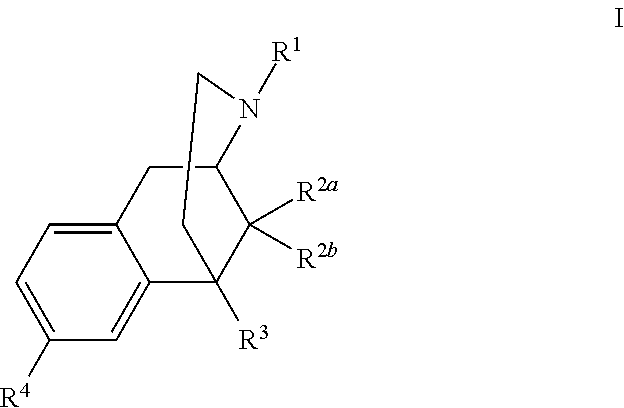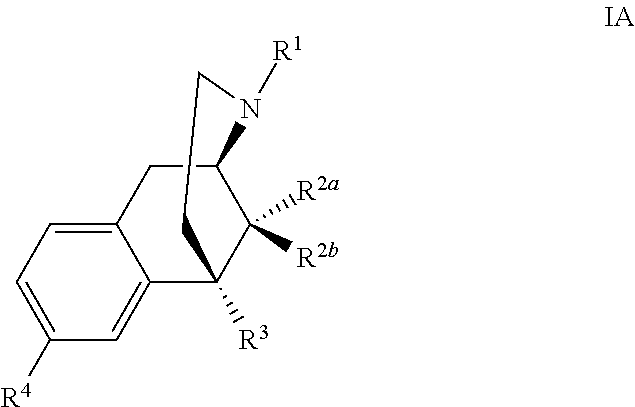Benzomorphan analogs and the use thereof
a technology of benzomorphan and analogs, applied in the field of medicinal chemistry, can solve the problems of not being able to assume that a drug is necessarily analgesic, cannot be applied specifically to opioids, etc., and achieve the effects of treating, or preventing constipation, and reducing or preventing constipation
- Summary
- Abstract
- Description
- Claims
- Application Information
AI Technical Summary
Benefits of technology
Problems solved by technology
Method used
Image
Examples
example 1
4-((2R,6R,11R)-11-(carboxymethyl)-3-(cyclopropylmethyl)-8-hydroxy-1,2,3,4,5,6-hexahydro-2,6-methanobenzo[d]azocin-6-yl)butanoic acid (10)
[0597]
[0598]NaHMDS (1M in THF, 1.935 mL, 1.935 mmol) was added at −78° C. to methyl diethylphosphonoacetate (0.284 mL, 1.548 mmol) in 1 mL THF and the solution, was stirred at −78° C. for 10 mm. Compound 1 (0.500 g, 1.290 mmol) in 2 mL THF was added and the solution stirred at −78° C. to RT for 18.5 h then at 60° C. for 3 d 17 h. An additional aliquot of methyl diethylphosphonoacetate (0.284 mL, 1.548 mmol) in 1 mL THF was mixed at 0° C. for 5 min then added to the reaction mixture, after which the solution was heated at reflux for 7 h. The reaction mixture was concentrated and purified by MPLC (0-50% acetone / hexanes, 12 g) to yield compound 2 as a yellow oil. Compound 2 was carried on as a mixture of the methyl and ethyl esters.
[0599]
[0600]TFA (4 mL) was added to compound 2 (360 mg, ˜0.81 mmol) and the solution was stirred for 19 h at RT. The solu...
example 2
(Z)-2-((2R,6S)-6-(4-amino-4-oxobutyl)-3-(cyclopropylmethyl)-8-hydroxy-1,2,3,4,5,6-hexahydro-2,6-methanobenzo[d]azocin-11-ylidene)acetic acid (11)
[0607]
[0608]10% Aqueous NaOH (0.160 mL, 0.400 mmol) was added to compound 7 (0.032 g, 0.08 mmol) in MeOH (0.5 mL) and the solution was heated at 60° C. for 21 h. The reaction mixture was concentrated and purified by reverse-phase prep HPLC [C18, 0-60% ACN / H2O (0.01% TFA)] to yield compound 11 as its TFA salt.
[0609]1H NMR: δH (400 MHz, CD3OD): 6.96 (d, J=8.1 Hz, 1H), 6.68 (d, J=1.5 Hz, 1H), 6.63 (td, J=8.1, 1.5 Hz, 1H), 6.33-6.17 (m, 1.5 H), 6.03-5.85 (m, 0.5 Hz), 3.39-2.87 (m, 5H), 2.69 (td, J=13.0, 3.5 Hz, 1H), 2.25 (td, J=7.0, 1.5 Hz, 2H), 2.15-1.89 (m, 3H), 1.71 (d, J=14.0 Hz, 1H), 1.66-1.46 (m, 2H), 1.11-0.97 (m, 1H), 0.76-0.56 (m, 2H), 0.45-0.28 (m, 2H).
[0610]LC / MS, m / z=385 [M+H]+ (Calc: 384).
[0611]In a similar manner, (Z)-2-((2R,6S)-3-(cyclopropylmethyl)-6-(4-dimethylamino)-4-oxobutyl)-8-hydroxy-1,2,3,4,5,6-hexahydro-2,6-methanobenzo[...
example 3
2-((2R,6S,11R)-3-(cyclopropylmethyl)-11-(hydroxymethyl)-8-methoxy-1,2,3,4,5,6-hexahydro-2,6-methanobenzo[d]azocin-6-yl)ethanol (19) and 2-((2R,6S,11R)-3-(cyclopropylmethyl)-11-(hydroxymethyl)-8-methoxy-1,2,3,4,5,6-hexahydro-2,6-methanobenzo[d]azocin-6-yl)acetamide (22)
[0617]
[0618]Ethylene glycol (80 mL, 1,523 mmol, 20 eq) and PTSA (14.5 g, 76 mmol, 1.0 eq) were added to a solution of ketone 14 (26 g, 76 mmol, 1.0 eq) in toluene (400 mL). A Dean-Stark apparatus was installed and the mixture was heated to reflux for 3 d. The mixture was cooled to RT. Solid K2CO3 (10 g) was added and then saturated aqueous NaHCO3 was added and the pH adjusted to 9-10. The layers were separated. The aqueous layer was extracted with DCM and the combined organic layers were dried over MgSO4. The concentrated crude oil was purified by flash chromatography (SiO2, 0-60%, acetone / hexanes) to obtain a yellow sticky foam. 21.5 g (73.2% yield) of compound 15 was obtained.
[0619]1H NMR: δH (400 MHz, CD3OD): 6.80 (...
PUM
| Property | Measurement | Unit |
|---|---|---|
| temperatures | aaaaa | aaaaa |
| pressure | aaaaa | aaaaa |
| temperature | aaaaa | aaaaa |
Abstract
Description
Claims
Application Information
 Login to View More
Login to View More - R&D
- Intellectual Property
- Life Sciences
- Materials
- Tech Scout
- Unparalleled Data Quality
- Higher Quality Content
- 60% Fewer Hallucinations
Browse by: Latest US Patents, China's latest patents, Technical Efficacy Thesaurus, Application Domain, Technology Topic, Popular Technical Reports.
© 2025 PatSnap. All rights reserved.Legal|Privacy policy|Modern Slavery Act Transparency Statement|Sitemap|About US| Contact US: help@patsnap.com



